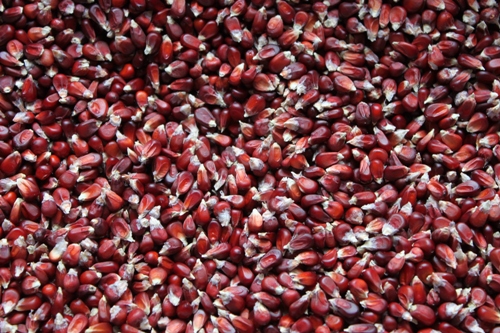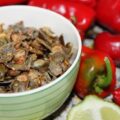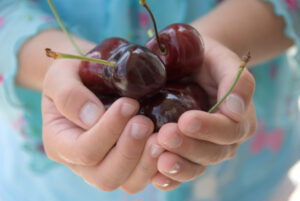
Virgil Evetts
I love popcorn (who doesn’t), and it’s one of those things I’d been thought about growing for years. How hard could it be after all? I couldn’t really see much point in growing the ordinary supermarket version though- it’s very cheap to buy, so hardly warrants the effort. I had however started to hear about an heirloom variety called strawberry popcorn, grown for 100 years or so by Maori communities around the East Coast, and possibly sourced from American whalers much earlier. Lynda Hallinan at New Zealand Gardener magazine had called it one of her top crops at one point, but it took me until this summer to get hold of seeds and experiment with a modest patch. Corn takes up a lot of space and is remarkably greedy compared to what it gives back, so I wasn’t about to turnover half the garden to what seemed like little more than a folly.
I rather wish I had. Although I only put in about 20 seeds, all came up and all produced multiple ears of rather gorgeous, merlot-toned, corn. Once harvested these spent several weeks drying on racks arranged under my portico, until they the husks were parchment dry and the individual kernels rock hard. Popping corn needs to ‘cure’ like this or it simply won’t pop.
So it was that I spent a very happy hour in the sun yesterday scraping the kernels from the cobs. As I worked away, twisting and tugging the hard, red kernels free of the cobs, I noticed that they were staining my fingers – or so I thought. On closer inspection and acknowledgment of the growing pain in my thumb I realised that I had managed to wear a rather deep, and now copiously bleeding, hole in said appendage. I’m a little worried that I didn’t notice this happening actually…
But after a brief first aid pit-stop, I resumed my work, this time wearing a chainmail butcher’s glove which made quick and painless work of the remaining cobs. To my surprise those 20 trial plants yielded nearly two kilos of dried and hulled popcorn. After careful winnowing the rather dusty corn in a stiff breeze, I heated a little olive oil in a pan, added a couple of tablespoons of corn, and … we I’m sure you know how to pop corn.
I think it would be an exaggeration to say the resulting billowy pillows of hot popcorn tasted better, or even very different, to the stuff you might buy from the supermarket, but it was most certainly well seasoned by the knowledge that I grew it myself and that it was incredibly fresh and grown without pesticides, fungicides or phosphate-based fertilizers.
With the obvious exception of organically certified product, commercial popping corn is virtually washed with pesticides and is grown in soil loaded with environmentally destructive phosphate fertilisers. Each to their own though, you know.
Now, before anybody asks, no you can’t pop just any old corn. It only works with certain varieties of maize, which dry to a rock-hard and hermetically-sealed solidity. When heated, pressure builds up inside the kernels until it explodes, or more accurately expands and inverts. Sweet corn and most flour corns are not sufficiently sealed to support the massive build of pressure required to turn a solid kernel inside out, and will simply fizz and splutter in the pan.
Popcorn is a snack I never tire of, preferably served piping hot and sprinkled with plenty of salt. Butter is all fine and good, but the real McCoy makes the corn soggy and the less said about artificial popcorn butter-salt the better.
Strawberry Popcorn seed is usually available from Koanga . Although currently out of stock they will have more before next spring.





wow that sounds like a magic moment – congratulations
We are lucky we have an certified organic grower who produces both pop corn and maize for polenta etc on the east coast for those of us unable to grow our own.
You have to invest in a whirly pop, my Canadian friend put me onto it and it’s really the only way to make popcorn.
looking forward to growing some of the strawberry popcorn, sounds great
I’ve grown this for the first time this year also. Handy to know it needs to go on a drying rack – I was going to leave to dry on the plant until the husks turn to parchment. Suppose that’s not the best idea in our autumnal Canterbury rains! Will pick soon – squeezing the cobs first to make sure they are mature.